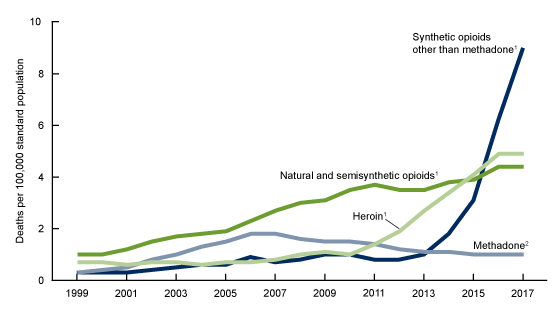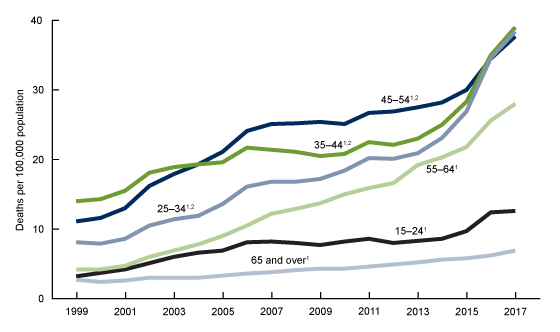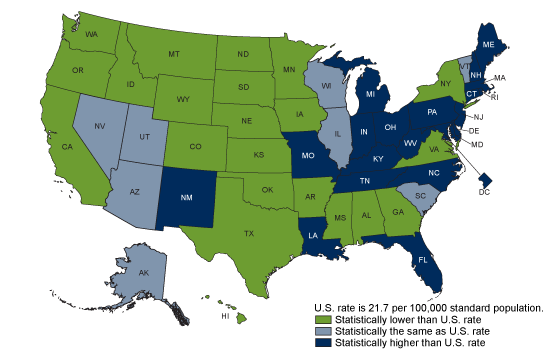
Editor’s note: This article originally appeared in ThinkAdvisor on September 26, 2019.
Although reports of opioid abuse started to become widespread in 2014 and this crisis was declared a public health emergency by the Acting Health and Human Services Secretary in October 2017, the “opioid epidemic” actually dates back to the 1990s.
This article will examine what caused this epidemic, how it has affected life expectancy for certain age groups in the United States, and how these life expectancy changes impact longevity and mortality risk management for life insurers and annuity providers.
Opioids on the Rise
After the 1995 approval by the U.S. Food and Drug Administration of an oxycodone formulation (OxyContin), better pain management in the United States seemed possible. Oxycodone was initially prescribed only to patients who had undergone surgery or cancer treatment, but later physicians increasingly prescribed them for chronic conditions such as back or joint pain.
What changed? Pharmaceutical companies made claims that the drug was safe and non-addictive in their marketing—although there was a lack of data to back these claims. In addition, in 2001, the Joint Commission rolled out new Pain Management Standards, which promoted the idea of pain as a “fifth vital sign.” It required healthcare providers to ask every patient they treated about their pain, and many hospitals, eager to improve patient satisfaction, encouraged physicians to seek ways to relieve or eliminate their patients’ pain. As a result, between 1991 and 2011 opioid prescriptions in the United States tripled, increasing from 79 million to 219 million per year. During roughly the same period, the United States experienced a significant increase in the number of deaths caused by opioid abuse. Mortality from heroin overdose, for example, increased by 286% from 2002 to 2013.
To address this increase in deaths, in March 2016, Massachusetts became the first state to enact legislation to limit the initial supply of opioid painkillers prescribed by doctors. Thirty-five more states have followed with their own policies and guidelines for limiting the supply, which made the drugs harder to obtain.
As a result, use of illicit opioids became more common by people who had become addicted to licit opioids after a prescribed course of them. Fentanyl, a licit synthetic opioid commonly mixed with illicit drugs such as heroin and/or cocaine and sold illegally, replaced other methods of opioid abuse. Not surprisingly during 2016-2017, we observed the sharpest rise in drug abuse-associated deaths, as shown in Figure 1.

Lack of Adequate Pain Management in the United States
More than 100 million American adults suffer from chronic or recurrent pain in the United States. These types of pain can be caused by various conditions, e.g., surgery, inflammation, musculoskeletal injury (involving the bones, muscles, or joints), nervous system dysfunction, chronic diseases, and autoimmune disorders. Chronic back pain and chronic headaches are the most common types of pain that cause disability, lower quality of life, and reduced work productivity. Unfortunately, there is no effective pain treatment, which makes the pain more difficult for physicians to treat and adequately control. This can lead pain patients to misuse prescribed opioids, thereby increasing their chances of becoming addicted, with life-threatening or -ending consequences.
Drug Abuse and Its Impact on U.S. Life Expectancy
Since late 1990, more than 300,000 people of all ages and both sexes in the United States have died from opioid overdose. The crisis has taken a higher toll, however, in the eastern part of the country and among people ages 35 to 54 years old. The states of West Virginia, Ohio, Pennsylvania, Kentucky, New Hampshire, Delaware, Maryland, Maine, Massachusetts, and Rhode Island have the highest age-adjusted death rates in the country (with the death rate > 31 per 100,000), as illustrated in Figure 2. The highest death rate occurred in West Virginia with 57.8 per 100,000 people.

According to the Substance Abuse and Mental Health Services Administration (SAMHSA), most people who reported prescription opioid misuse started in their 20s; this is one of the reasons that the opioid-related death rate for adults between the ages of 25 and 54 is the highest, as illustrated in Figure 3. The significant increase in mortality in this age group has impacted life expectancy in the United States since 2015. While this impact is not expected to be severe for life insurers and annuity providers, an in-depth understanding of what is driving impacts on mortality, through stochastic modeling, can lead to better risk management decisions.

Economic and Societal Impacts
In addition to overdose deaths, the opioid crisis has had negative economic and societal impacts in the United States, such as loss of wages; loss of work productivity; additional health care costs; and additional spending on social services, consumer education, and the criminal justice system. In terms of healthcare costs alone, preliminary estimates from the U.S. Department of Defense for various certified treatment programs run to anywhere from about USD 6,000 to about 14,000 per year, per patient. The Council of Economic Advisors (CEA) place the total cost in 2015 for the United States at USD 504 billion, including both fatality (USD 431.7 billion) and non-fatality (USD 72.3 billion) costs.
Government Policies, Action, and Response
Different government departments and many organizations have worked to resolve the national opioid epidemic in the past decade or so. The CDC has outlined how to prescribe drugs; continues to monitor overdose cases and deaths; and tries to control the amount of prescriptions. In addition, the Substance Use-Disorder Prevention that Promotes Opioid Recovery and Treatment (SUPPORT) for Patients and Community Act was enacted last year to address the opioid overdose crisis. This law’s goals are to: stop the flow of illicit opioids; expand existing programs and create new ones to prevent and treat substance use disorder and overdoses; provide more funding for treatment programs and research on development of new drugs and treatment; and monitor the situation and report the effectiveness of programs to Congress.
While this bipartisan effort may not be solely responsible, after three spikes in drug overdose deaths in the years since 1999—from prescription opioids, from heroin, and from synthetic opioids—it is worth noting that in 2018 there was a decline in opioid-associated mortality in the United States.
Life insurance agents help their clients choose the right life and annuity products to protect their assets against the unexpected. At and beyond the point of sale, when reviewing life expectancy assumptions and projections, life insurers, too, must consider the possible ways in which opioid abuse and other emerging risk factors might impact policies in their portfolios. Probabilistic models that account for life expectancy improvements and degradations by age group and lifestyle can support such informed decision-making for improved financial strategies.
Can Opioid Crisis-Related Losses Be Quantified? Read the blog.


